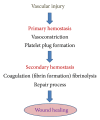Overview of platelet physiology: its hemostatic and nonhemostatic role in disease pathogenesis
- PMID: 24729754
- PMCID: PMC3960550
- DOI: 10.1155/2014/781857
Overview of platelet physiology: its hemostatic and nonhemostatic role in disease pathogenesis
Abstract
Platelets are small anucleate cell fragments that circulate in blood playing crucial role in managing vascular integrity and regulating hemostasis. Platelets are also involved in the fundamental biological process of chronic inflammation associated with disease pathology. Platelet indices like mean platelets volume (MPV), platelets distributed width (PDW), and platelet crit (PCT) are useful as cheap noninvasive biomarkers for assessing the diseased states. Dynamic platelets bear distinct morphology, where α and dense granule are actively involved in secretion of molecules like GPIIb , IIIa, fibrinogen, vWf, catecholamines, serotonin, calcium, ATP, ADP, and so forth, which are involved in aggregation. Differential expressions of surface receptors like CD36, CD41, CD61 and so forth have also been quantitated in several diseases. Platelet clinical research faces challenges due to the vulnerable nature of platelet structure functions and lack of accurate assay techniques. But recent advancement in flow cytometry inputs huge progress in the field of platelets study. Platelets activation and dysfunction have been implicated in diabetes, renal diseases, tumorigenesis, Alzheimer's, and CVD. In conclusion, this paper elucidates that platelets are not that innocent as they keep showing and thus numerous novel platelet biomarkers are upcoming very soon in the field of clinical research which can be important for predicting and diagnosing disease state.
Figures








References
-
- Ribatti D, Crivellato E. Giulio Bizzozero and the discovery of platelets. Leukemia Research. 2007;31(10):1339–1341. - PubMed
-
- Cerletti C, Tamburrelli C, Izzi B, Gianfagna F, de Gaetano G. Platelet-leukocyte interactions in thrombosis. Thrombosis Research. 2012;129(3):263–266. - PubMed
-
- Vinik AI, Erbas T, Sun Park T, Nolan R, Pittenger GL. Platelet dysfunction in type 2 diabetes. Diabetes Care. 2001;24(8):1476–1485. - PubMed
-
- Sharma G, Berger JS. Platelet activity and cardiovascular risk in apparently healthy individuals: a review of the data. Journal of Thrombosis and Thrombolysis. 2011;32(2):201–208. - PubMed
-
- Michelson AD. Flow cytometry: a clinical test of platelet function. Blood. 1996;87(12):4925–4936. - PubMed
Publication types
MeSH terms
Substances
LinkOut - more resources
Full Text Sources
Other Literature Sources
Medical
Miscellaneous

